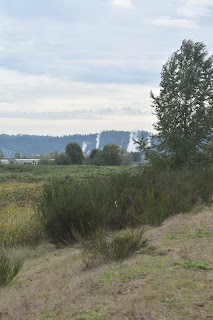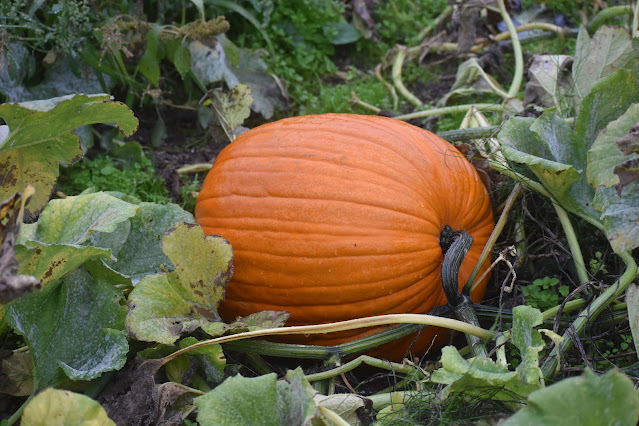One more loop
"But we need to get you your Canada Jay first," Andrew said as he got the dogs ready for a morning walk. The birds really are a common enough sighting for him on his property, but our swing around the forest and fields left me CAJA-less. Pileated Woodpeckers called excitedly throughout the walk and we had at least one set of calls that got our hopes up.
Breakfast in me, but no Scrabble before I had to go. Clearly Andrew was content with the 1-0 series lead he holds over me.
. . .
I thanked the Emlens one more time before I had to hit the road, thankful for the generosity of time, food, shelter, and company.
West Valley Road to East Valley Road to Highway 8 to the entrance of Julia Butler Hansen. There I found my three travel companions for the day waiting for me. We talked over plans and targets, and it became clear that they were going to follow my lead for the day.
As an ENTP. . . this is too much responsibility. When I'm running around solo on trips, it's never without thought. It's never without a carefully calculated plan scribbled out on several notebook pages. I. . . just deviate from those plans with perfect ease. Nonetheless, I located the most decisive version of myself, and had him say, "Let's go to the White-tail Trail".
True, I'd been there the previous day, but they were convinced (as Andrew and Jake had been) that there were Lincoln's Sparrows waiting for me there, and numerous other possible species. Along the way, we got Becky up to speed on spotting Great Egrets. Many people might not notice the birds, but once you learn some of the basic field marks, it gets much easier to spot these beautiful birds - something we did with greater and greater intentionality over the course of the day.
The salt water remained mostly empty. Gulls would float by. . . brown, confusing gulls, for the most part. We opted out of even trying to call any of them Herring Gulls.
Puget Island
There were numerous species that we thought might be found on Puget Island: Lincoln's Sparrow, Cooper's Hawk, Rough-legged Hawk, Western Meadowlark, Herring Gull, Bonaparte's Gull, Snow Goose, Merlin, and American Pipit (with imaginative thoughts of pheasants and quail). Randy had worked this area for the Christmas Bird Count on numerous occasions, so we followed his lead for the first part of the exploration.
I was honestly kind of amazed that, as we stopped at good Lincoln's Sparrow spots, we kept coming across Savannah Sparrows! I know that they overwinter here and there in the state but was hard-pressed to think of a time that I'd seen so many in a winter-ish month.
 |
| One of at least two Washington State Ferries that I have never boarded. |
 |
| These are not the gulls you're looking for. |
We pulled over once in a while and could see a time or two when Russ and Becky pulled over behind us. On one occasion, they pulled ahead of us to let us know there was a Cooper's Hawk in a tree. We made our way back, and i got a brief but satisfying glance at it before it took flight behind some trees. (146 for the Wahkiakum year!). We passed the lead off to Russ and Becky, and they led us off to the far Northwest corner of the island, where a short walk brought us to a gull roost. They were all Ring-billed and California Gulls, but it was still nice to find a new place on the island. I'd never wandered to this little spot, and apparently a White-breasted Nuthatch had been found here a few years back.
At one point we stopped, and I swore that I heard a Western Meadowlark singing. Becky looked at me, and I could tell. . . "Tell me what bird you just heard..." I smiled. "Western Meadowlark." We got one more bit of song, and high-fived for bird 147.
 |
| Views from Puget Island |
Cathlamet - the Spar
I'm pretty sure everyone else had come a bit more prepared, but I was again running around lunchless, and guided us to the Spar for lunch.
 |
| This is the list we were looking at, minus birds seen on the trip |
In addition to fighting the hangries, I needed the stop to look things over and make a decision for the rest of the day. We ran through the list of remaining year-birds in Wahkiakum with the question: will they be easier in December than October? In the end there were a few that were a yes: Snow Goose, Dunlin, White-throated Sparrow, and *maybe* Herring Gull.
I thought this over, together with some hopes of finding a Canada Jay or Northern Pygmy Owl with Andrew in December, and decided it was time to leave Wahkiakum. It's hard to imagine leaving a county that should be one of the hardest to get to 150 for the year, but I'd given it a pretty good effort just to bring it from 139 to 147. The Lincoln's Sparrows had been given plenty of time to show themselves. Additionally, there was time left in the day to finish off Cowlitz County, something that would pave the way for an easier end to the year.
Lunch was mostly good. Good bean soup. Good chili. Randy got a breakfast sandwich with a choice of meats. He chose sausage. He got an egg between two pieces of bread! That said, it's really the only time service has slipped there on my stops. I wouldn't hesitate to stop there on future trips!
Cowlitz
 |
| Longview Mint Farm |
But let's be honest. The back of this bird does look like a Lincoln's Sparrow. I've been trying to notice things like that. . . well, at least a little bit more. It seems like there are the usual field marks to look for with any bird. But what if those marks aren't visible. . . ? So, although I saw the bird better than this picture shows, I'm still happy with the picture.
From here, we made a beeline for Woodland Bottoms.
Woodland Bottoms. . . dang it, where are you hiding the Rough-legged Hawks? I know it's a bit early for them now, but this has been one of the "easier" birds eluding me this year. Them and the Meadowlarks. My eyes were peeled for these species as we drove.
 |
| Apparently this ferry can take you from the mouth of the Columbia River to the Snake River. . . for only 5000 dollars! |
Once again, Russ and Becky pulled over, and pointed excitedly at the fields to the East. I got out with equal excitedliness, wondering what bird was going to be 149. . .
:)
I was glad to see that my birding companions for the day had now fully embraced this magnificent bird and had no compunctions against playing with my hopes. Becky had done the birding equivalent of rickrolling me. 10/10.
But during a similar pull over, we once again found some Western Meadowlarks down in the fields (149!).We tried the Columbia for a bit, hoping for a Common Loon, or a Western Grebe. We got the latter, but the bird was across the river in Oregon. An interesting thing happened at that point. Universally, the people in the group asked me if I wanted to count the bird. I did not, (all of my counted birds on all lists are *in* the county, rather than just viewed from the county), but this was a nice example of "your list is your list" in practice.
My lists are more rigorous than some because of this self-imposed rule. It's also less rigorous than others lists, because I do count heard-only birds. Some people will only count a bird that is seen. Others will only count birds that are photographed! While these different degrees of rigor can lead to elitism, the countermeasures against that elitism are simple: Your list is your list. I already knew that I was in good company on this particular day, but this was a nice confirmation of that assessment.
We continued to the area of Martin's Bar where Horned Larks are often found. Russ and Becky both noted that they had not been seen in several weeks, but I certainly didn't mind getting to know Woodland Bottoms a little better. The beach itself is one place to look for these birds; they can also be found in the larger area, back from the river a little, which had been filled in with dredge.
We didn't turn up any larks and continued along the dike road to Austin Point.
I have no idea how everyone else found the Greater White-fronted Geese 93 million miles out into the field, but they did. I got a look through the spotting scope. 150!
 |
| We saw one or two of these: Smoky-winged Ash Aphid I'd seen them before (in swarms) but finally got around to identifying them. So pretty! *not my photo! |
So, Cowlitz joined the list: King, Thurston, Island, Mason, Chelan, Kittitas, Snohomish, Yakima, Lewis, Pierce, Douglas, Klickitat. . . and now Cowlitz County were all places where I'd dedicated enough attention for a year and picked up 150 species. 26 left! :D Although, I'm quite happy to stay focused on the idea of "3 left!". It's "only" 11 birds left that I have to find for the year (4 each in Clark and Skamania, and 3 in Wahkiakum), but . . . this was close enough to still have me sweating. We'll leave it at that.
I had the chance to keep birding with Becky and Russ but thought it would be even better to get home at a reasonable hour and celebrate a few great days of birding.
 |
| One county down! |

























.jpg)
.jpg)
